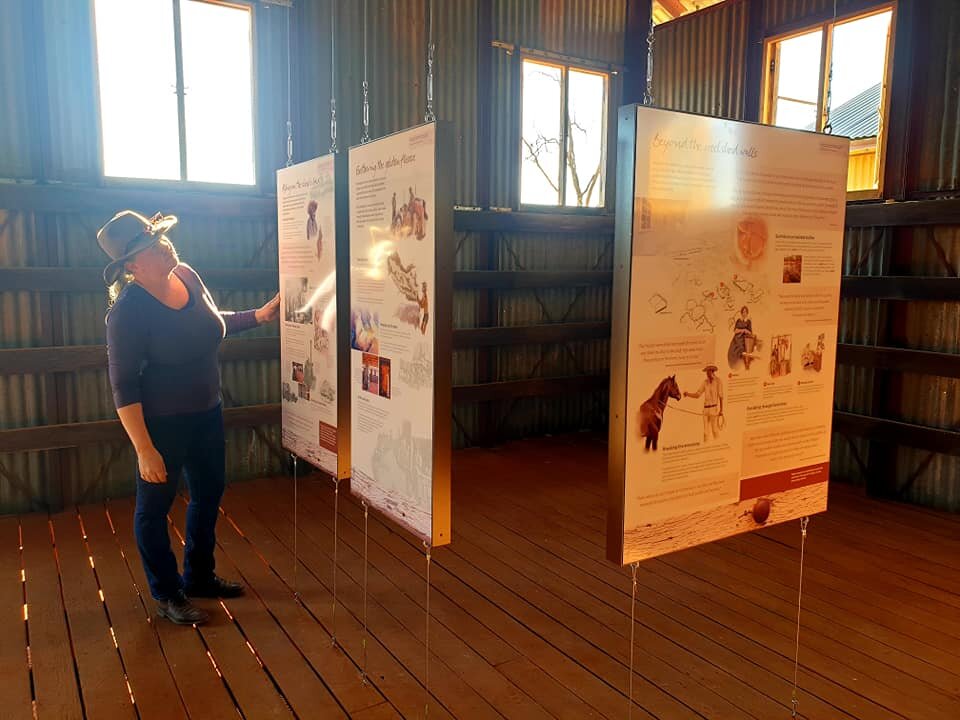Top takeaways from the Currawinya National Park sign project
How the right planning helped set us up for success
In case you’ve missed our adventures out west, we’ve been working on an interpretive sign project for Queensland Parks and Wildlife Service (QPWS) in Currawinya National Park.
Isolated and beautiful, Currawinya National Park is 828 km west of Brisbane, and 14-minutes drive from the nearest outback township of Hungerford, nestled on the Queensland and New South Wales border.
Our task? To write a series of interpretive signs that would engage visitors travelling to this remote, harsh environment.
Large-scale interpretive projects are one of our favourite things to work on. So, we’re sharing some of the important planning steps we took to help make this project a success.
Credit: Robert Ashdown
1. Get to know your location
Interpretation is a powerful way to strengthen a visitor's relationship with a place and its features. More than just ‘telling’, interpretation involves translating information and facts into content that forges an emotional and intellectual connection with the reader.
Credit: Robert Ashdown
To do this well, you need to know what you’re talking about.
Before we began writing, we made the hot, dusty journey to visit Currawinya National Park. We were accompanied by rangers who intimately knew the area, its values and its history.
During this visit, we brainstormed creative ideas and identified opportunities and potential problems. It allowed us to plan the next stage of the project with confidence.
Some of the questions we explored were:
What interpretive work has been done here before? What worked and what didn’t? And why?
How will information on the new signs complement other communication at the site?
What are the plans for the site? How will signs installed now be affected in the future?
Visiting the site in-person also allowed us to assume the role of the ‘visitor’. As we travelled through the park, we could identify obvious physical features that might spark a visitor’s curiosity. Some of these included old relics, species of animals and abandoned buildings. We then used these observations later to guide our sign content plan.
2. Keep the visitor firmly in mind
Who will be reading your signs and how can you connect them to the significance of your ‘place’?
Most visitors to Currawinya National Park are experienced travellers, eager to explore this remote part of Queensland. To create an engaging experience for this audience, we needed to consider their motivations for visiting.
Rugged and with basic facilities, Currawinya National Park is not for the faint-hearted. Visitors are often prepared to ‘rough it’ in exchange for a quiet, reflective outback experience. And after a long drive, information about what to see and do can be considered a reward. It adds to the sense of discovery and adventure.
Credit: Robert Ashdown
To understand the visitor’s needs, we asked ourselves:
What information will they be looking for?
How can we share the hidden stories that shape this landscape?
What’s our opportunity to create a deeper understanding that will last long after they leave?
We also thought about what visitors may already know about the park. Most remote travellers do pre-visit information to plan their trip and ensure their safety.
With this in mind, we knew the interpretive signs would need to expand on any pre-visit knowledge and offer something new. They would need to both satisfy and pique curiosity, leaving the visitor wanting to know more.
3. Consider the visitor journey
Interpretive signs work best when they consider the overarching visitor experience.
Currawinya is one of Queensland’s largest parks, with tourist sites scattered throughout. Visitors may view any number of signs across various sites.
Regardless of which signs are viewed, and in what order, we needed to create an experience that would feel logical and complete.
We considered where the visitor may have been before, and where they were likely to go next?
In some places, signs would need to help the visitor at the start of their journey, orienting them in the landscape and providing essential information. In other places, signs would need to tell a unique story and engage the reader in deeper thinking.
Credit: Robert Ashdown
We also considered how visitors would interact with the signs. Some of the questions we asked were:
How will the visitor use this space? Where will they enter and exit? What location will allow the sign to be viewed easily?
How long will visitors stop at each site? Will they have time to read long-form copy or prefer a quick account of events?
Will the proposed location of a sign be accessible for all ages and abilities?
What size should the sign be? Will the size and shape be appropriate for the space or block views or attractions?
Credit: Jo McLellan
4. Tell the stories that matter
Storytelling is a way to help visitors understand another person’s experience. They can reveal hidden meanings and contexts that surround an object, place or time. With the right content, we can make people listen, care and act.
Currawinya National Park is an ancient landscape, holding the stories and traditional knowledge of the land’s Traditional Owners, the Budjiti People. The new signs provided an opportunity for appropriate stories to be shared.
The signs also needed to share information about pastoral settlement in the area and the role of Queensland Parks and Wildlife Service in protecting environmental and cultural values.
We needed to share powerful and factually correct stories, capturing multiple stakeholder perspectives.
To do this well, some of the questions we asked were:
Who are the stakeholders in this project? Who are the people and groups who need to be involved?
Are there important perspectives that should be represented? Do these perspectives need to be handled with specific process and sensitivity?
Who are the experts on these issues? Who has the authority to share information?
From there, we scheduled meetings to build our knowledge. We met with a Budjiti cultural liaison who could speak on behalf of the Budjiti People. We also met experts in artesian springs and local vegetation, and locals with firsthand experience in sheep shearing.
Credit: Jo McLellan
Moving on to the next step ...
The insights and discoveries we made during planning helped us make strategic decisions during the next project stage. Planning helped inform the:
content strategy (what information should be included on each sign, and the information hierarchy on each sign)
research strategy (identifying what should be investigated, and what material could support our writing)
themes and messages (the ideas that would shape the content and create meaning)
writing style, voice and tone that would connect with the visitor.
Interpretive signs are costly and require an investment of time and resources. Planning will not only help you achieve the project objectives but elevate the outcomes.






